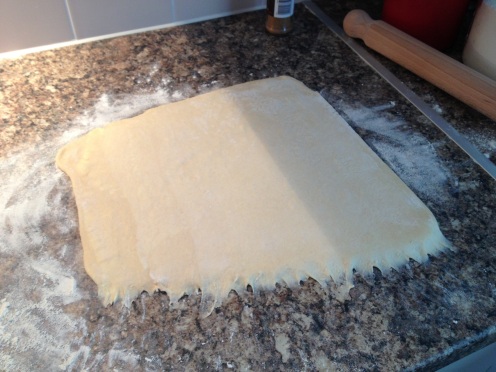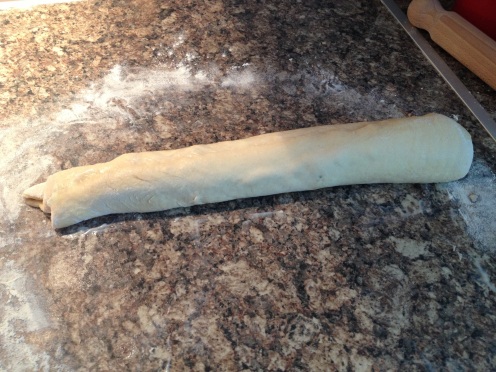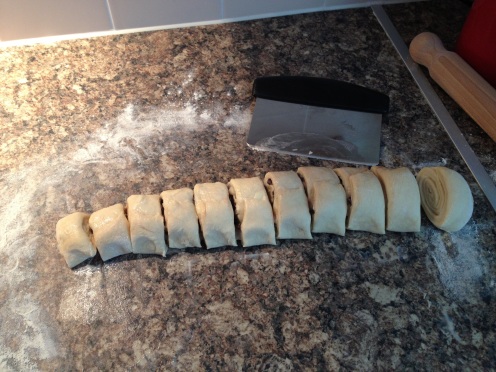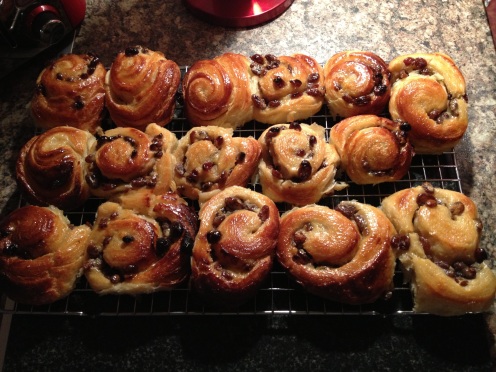Paul Hollywoods Pain Aux Raisins

I think the BBCs Great British Bake Off has started everyone baking. And I’m no exception. I even went baking mad for a month and applied for the show (all to no avail unfortunately).
I also ended up buying Paul Hollywoods how to bake book and have been slowly been working my way through the book, having a go at pretty much all of the stuff in it. I made croissants the other week and they were fantastic, extremely time consuming for a batch of 12 but it was worth it.
The next recipe was Pain Aux Raisins, just as time consuming ill admit but based on the success of the croissants I’m giving it a go. Here’s what I did:
*Before I begin with the recipe ill make it perfectly clear that from starting out to the end product, you are talking 2 days. It will become apparent why but make sure your prepped with a ten ton of patience before you start tackling this beast of a recipe.
Right, firstly you’ll need to make the base dough:
500g strong white bread flour
10g salt
80g caster sugar
10g instant yeast
2 medium eggs
90ml cool water
125ml tepid full fat milk
250g butter
Get a mixer with a dough hook attachment at the ready and place the flour, salt, sugar and yeast in the bowl making sure the salt and yeast are at opposite sides of the bowl. Then add the eggs water and milk and mix on a slow speed until well combined. Knock the mixer up to a medium speed and carry on ‘kneading’ the dough for around 6 more minutes.
Tip the dough out onto a lightly floured surface and shape into a ball. Dust with flour and place in a plastic bag and chill In the fridge for an hour.
After chilled, roll out the dough into a rectangle, about 50x20cm and 1cm thick. Then flatten the butter between two sheets of grease proof paper with a rolling pin to about 33x19cm. Lay the butter so that it covers the bottom two thirds of the dough.
Fold the exposed dough over one third of the butter. Now gently cut the visible bit of butter and place it on top of the bit of dough you just folded down. Fold the bottom half of the dough back up on top of the butter to create like a sandwich layering with two layers of butter and 3 of dough. Pinch the edges to seal in the butter and put back in the plastic bag and chill in the fridge for another hour.
Once again, after rested place the dough on a lightly floured surface and roll out to 50x20cm as before making sure the short end is facing towards you. This time fold up one third of the dough and then fold the top third down on top. This is a single turn. All in all you’ll need to do at least 3 but you’ll need to chill the dough after each ‘turn’
Once all the ‘turns’ are done leave the dough to rest overnight in the fridge to rest and rise slightly. After this it’ll be ready to use.
This is the most laborious part of the recipe done. It’s quite similar to making puff pastry with the layers. In Paul’s book there were the addition of pictures which showed a step by step guide of how to do it, I know I’d have struggled without them (not going to lie).
So, back to the next step. The crème patisserie.
100g caster sugar
4 medium egg yolks
40g corn flour
500ml full fat milk
1.5 tablespoons of good vanilla extract (it says use 2 pods in the book, and you can, I just used a good vanilla extract because it was in the cupboard, plus it’s too expensive for pods these days, let alone 2!!!!)
40g butter
Right, whisk the sugar, egg yolks and cornflour together till well combined.
Whisk in the milk and vanilla extract and put into a saucepan and heat until thickened. Just remember that once it cools its going to be thicker than in the pan so take it off before you think you should.
Pass the mix through a sieve, make a cartouche then place on top to stop a skin forming and chill in the fridge to completely cool.
These are the main two elements for the Pain Aux Raisins, and are skills to make In themselves to be honest. The assembly of the ingredients has yet another skill: The Roll.
For the Pain Aux Raisins themselves you’ll need:
The base dough
The crème patisserie
225g raisins
1tsp ground cinnamon
2 medium eggs, beaten
150g apricot jam to glaze
200g icing sugar
2 tbsp of water
Finely grated zest of 1 lemon
You start with the rested dough. Cut it in half and roll out to a rectangle so that the long edge is facing you. Press down the bottom edge of the pastry to the worktop. This bit isn’t in the book but I’ve seen it somewhere and I’m telling you it makes the rolling of the dough soooooooo much easier.
Smear half of the crème patisserie over the dough leaving a 5cm gap along the near edge then add half the raisins on top along with a sprinkle of cinnamon on top of that.
And so, time for the roll.
You’ll need to keep tension on the roll so that its as tight as possible (this is where pressing one side of the dough to the worktop helps so much). Each time you do a roll, give it a gentle tug towards you to tighten the roll and keep that tension against the pressed side of the roll. Once rolled all the way, roll it back and forth a few times to seal the join. Repeat with the remaining ingredients.
When you have both rolls completed, cut the rolls into 3cm slices and lay the cut side up and apart on the lined baking trays and leave to rise at room temperature for around 2 hours.
Heat the oven to 200 degrees C and brush the risen pastries with the egg and bake for 15-20 mins until golden brown.
Meanwhile heat the apricot jam in a pan with a little water then sieve. As you take the pastries out of the oven, brush with the jam and move to a wire rack to cool.
Once cooled mix the icing sugar, water and lemon zest until smooth and drizzle over the cooled pastries.
I know the whole process is a massive effort but its totally worth it. Not too shabby for my first attempt either…….








You definitely don’t put butter in the creme patissiere.